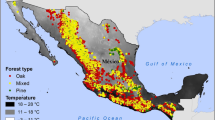Summary:
Since traditional agriculture and forestry are no longer economically viable in many regions of the European Alps, subalpine forests will become less managed or completely abandoned in the near future. Therefore, the interest in understanding how forest stands will develop after abandonment has increased considerably over the past two decades. While much is known about stand structure and stand development of Norway spruce (Picea abies L.) forests, almost no knowledge is available about the same processes in forest communities of the Central Alps. In the Swiss National Park (SNP), the forested area is comprised of mountain pine (Pinus montana Miller), Swiss stone pine/larch, (Pinus cembra L./Larix decidua L.). and mixed stands. When the Park was founded in 1914 all management activities were stopped. Therefore, this area offers the opportunity to study stand development and changes in stand structure after abandonment. We compared historic (1957) and present data (2001/02) from 19 stands that were grouped into characteristic stand types: “mountain pine”, “mixed”, and “stone pine”. We detected significant decreases in total tree density (stem/ha) and sapling density (saplings/ha) of 45 to 57%, and 64 to 76%, respectively, over the 45 years of observation for all stand types. These changes were strongly related to decreases in the number of shade intolerant mountain pine trees. Simultaneously, the amount of non-standing woody residue increased from less than 4 t/ha to 36 to67.7 t/ha, and the density of standing dead wood (stems/ha) decreased significantly between 72 and 94%. The biomass of standing dead wood (t/ha), however, changed only slightly between 1957 and 01/02. Our results describe the successional development of continental subalpine forests after abandonment and outlines changes that might take place in similar areas in the near future.
Zusammenfassung:
Die traditionelle land- und forstwirtschaftliche Nutzung dürfte im Alpenraum in der näheren Zukunft wirtschaftlich bedingt immer häufiger aufgegeben werden. Dieser Trend wird mit großer Wahrscheinlichkeit die Dynamik von Gebirgsökosystemen und damit das Landschaftsbild stark beeinflussen. Aus diesem Grund stieg in den letzten Jahrzehnten das Interesse, die Sukzession auf nicht mehr bewirtschafteten Flächen zu verstehen. Die Bestandesstruktur und -entwicklung von subalpinen Fichtenwäldern (Picea abies L.) wurde bereits intensiv untersucht; über Entwicklungsprozesse in zentralalpinen Bergföhren- (Pinus montana Miller) und Arven-/Lärchenwälder (Pinus cembra L./Larix decidua L.) ist hingegen nur wenig bekannt. Der seit 1914 vom Menschen nur noch touristisch genutzte Schweizerische Nationalpark (SNP) ist eines der wenigen Gebiete in Westeuropa, welches über längere Zeit nicht bewirtschaftet wurde. Der Park bietet daher die einzigartige Möglichkeit, die Veränderungen in Bestandesstruktur und -zusammensetzung nach Bewirtschaftungsaufgabe zu beobachten. Wir verglichen historische (1957) und aktuelle (2001/02) Daten von 19 Beständen, welche zu drei verschiedenen Bestandestypen gehören: „Bergföhre“, „Mischbestand“ und „Arve“. In den letzten 45 Jahren nahm die totale Stammzahl in allen drei Bestandestypen um 45 bis 57% und die Jungbaumzahl pro Hektar um 64 bis 76% signifikant ab, was vor allem auf den starken Rückgang der lichtbedürftigen Bergföhre zurückzuführen ist. Parallel zu dieser Entwicklung, nahm die Menge an liegendem Totholz in allen Bestandestypen von weniger als 4 t/ha auf 36 bis 67,7 t/ha zu, während die Anzahl toter Bäume pro Hektar um 72 bis 94% abnahm. Die Biomasse des stehenden Totholzes (t/ha) hat sich hingegen nur leicht verändert. Unsere Resultate beschreiben die sukzessionale Entwicklung von subalpinen Wäldern der Zentralalpen und zeigen, wie sich Wälder in ähnlichen Berggebieten in der nahen Zukunft entwickeln könnten.
Similar content being viewed by others
Author information
Authors and Affiliations
Corresponding author
Rights and permissions
About this article
Cite this article
Risch, A., Nagel, L., Schütz, M. et al. Struktur und Langzeitentwicklung von subalpinen Pinus montana Miller und Pinus cembra L. Wäldern in den zentraleuropäischen Alpen. Forstw. Cbl. 122, 219–230 (2003). https://doi.org/10.1046/j.1439-0337.2003.03011.x
Published:
Issue Date:
DOI: https://doi.org/10.1046/j.1439-0337.2003.03011.x
Keywords:
- Stand dynamics
- long-term forest development
- Swiss National Park
- subalpine conifer forests
- Swiss stone pine
- mountain pine




